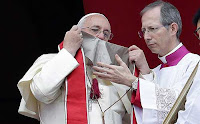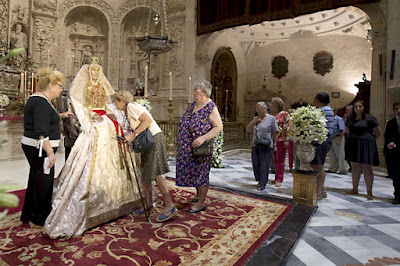December the 18th is the beginning of the octave to the Nativity of Our Lord, and in Spain, since the 7th century, we celebrate the expectant Virgin. We spoke of the iconography on the last post which you can consult here.
As we discuss in our book about the Gothispanic and Early Mozarabic Rite, the object of devotion, the one we show reverence or dulia-to is placed in the middle of the choir according to our ancient tradition. (We also speak of that here, and how even in Rome this is still done for the Christmas mass... though only for that one).
So, in Spain, where rather than icons, polychrome statues of surreal perfection came to be the artistic expression which the-faithful-hands-of-artisans found, and harnessed, to manifest their own devotion: we get life-sized images of the virgin and the saints which are taken out in processions and on their feasts, are placed in the middle of the choir to be remembered, feted, and venerated. This is mostly just in places like Seville, Malaga, Cordoba and other particular sees... but worth noting.
Veneration, we must explain, is different from "worship" in the sense some people accuse.
God alone is honored with latria or mirrored-heavenly worship such as with the singing of the Sanctus, Hallelujas and the mass itself - whereas the lesser sort of "earthly worship" which we call dulia (or hyper-dulia in the case of the Theotokos, The Virgin Mary, as defined in Greek) is more aptly called veneration.
A kiss is to Veneration-Dulia what Absolute-Surrender is to Latria. The later is expressed to God alone, whereas veneration is shown to the Saints, and all that is holy, or one wishes to honour here on earth.
Here are the four recognized levels of "worship" or "recognition of worth" if we understand the etymology of the word "worship":
The simplest is a bow of the head, the neck or waist.
A bow is an explicit acknowledgement or concord between two persons. Especially when it is simply a bow of the head, it is known as a nod. It can express assent or even a hello. The honor, or recognition of worth of the other, is achieved by his or her acknowledgement.


A reverence is one step above a nod but below veneration, and it is the sort of curtsy or genuflecting one does as a sign of respect. One does it to the altar, a magistrate, an assemblage of person upon entering a room, or an exalted personage. It acknowledges a difference in rank, as the lowering of the body, often by bending the knee, manifests a courteous humbling in front of a person or thing we salute as greater than ourselves - in piety, in power, authority, office or personal virtue...


Death is also acknowledged this way, even by princes, when royal standards fly at half mast or are draped in black.
A veneration, or the act of kissing the robe, the hand, the forehead, or the ring of someone is a step above. It is an act of devotion above mere respect. It is an expression of love, superlative care, honour or an acknowledged bond, admiration, or closed hierarchy. Whereas a bow or a reverence can be done from afar, an act of veneration denotes a familiar proximity. It is not uncommon in certain families to kiss the hands of their grandparents, parents, priests, princes and other persons with who they may have a relationship which merits such a sign of utmost respect.
Adoration, again, is even a step above and should be rendered to God alone. Such is the commandment. It is usually reserved for the manifest or symbolic manifestations of God: at The Sanctus, at the Sacrifice of the Mass, to accept the Eucharistic Meal, or contemplate the Holy Presence at a monstrance as many do. He is manifest also in the poor and the hungry which the Church must embrace in Charity - and reason why the priests kiss the feet of the poor on Maundy Thursday. It is also the stance we take when receiving a solemn benediction when God is invoked. For statues representing God, it is usual to kiss the feet - be He the babe in the manger, the adult during the passion, or his cadaver, tenderly cared for during the Holy Triduum (in some parts) before the entombment in view of the resurrection.
It is exactly what is done in The Roman Rite on Good Friday too, when the priest and the faithful also go up to the crucifix and kiss The Christ. Though, truly, the Spaniards make it a bit more traumatic in its realistic depiction of the wounds, the blood and glass or resin tears on his mother's face... often reflecting inside their frozen form, the collective empathy from those gathered to witness the reverent re-enactments before the Resurrection. People do cry as though it really was a loved one ... and perhaps, rightly so. It is very moving to experience Holy Week in Seville, where even cynics (I have witnessed) at certain points break down and shed themselves a tear... or an ocean's worth. And perhaps empathy is the key of it all!
That said, what we show to The Saints (the heiligen, the holy) is generally a form of veneration. This is why holy relics are kissed, the consecrated colours, the vestments used at the altar, the altar, and sometimes, also the icons or statues which represent the memory of one such exalted, holy person. That: includes The Virgin Mary.
On Her feast, the pregnant virgin is placed in the middle of the quire of the Church, as anciently done for other things and persons which are holy, live a holy life in the sacraments, or die within them (according to our tradition).
Her devotees file past and kiss her hands. These days, she has many feasts and advocations celebrated throughout the year - for some, she will hold the baby Jesus, but for her peculiarly Gothispanic Feast and Octave to The Nativity, since the seventh century, in Spain, the child is inside her belly. The Virgin is still pregnant, expectant, and quite full of Glory:
This is called her besamanos. And people perceive it as wildly strange outside of our cultural milieu. In America, for example, many find it quite distasteful...strange... and uncharitable accusations of idolatry are often shouted without a second of discernment to understand WHAT is going on.
This particular tradition of placing the life-sized Virgin and having people pass by to kiss her hand is mostly an innovation introduced only a couple of hundred years ago... just an extrapolation, however, of what in smaller scale is millenary in the continent, and particularly, our peculiar tradition in what is today Spain, Portugal and the south of France.
These Spanish besamanos, instead of just kissing a relic or small representation of the virgin, begin in the context of social unrest in which the monarchy had been contested, abolished, detested and defended by fellow countrymen which ultimately leads to a Civil War... many changes in government, in heads of state... a republican era, a dictatorship... two world wars... and the church herself was suffering the period in which all her assets were nationalized, religious edifices burnt, thousands of priests murdered, and the last of the colonies had declared independence... it was just a turbulent time for Spain, especially from the late 1800s and about a century long. These are not statues:
The expectant Virgin, La Virgen de La Esperanza (of Hope) was a rallying point in the darkest days (the autumn which turned to winter) and the faithful needed to cling to The Hope symbolized by the Nativity an octave later. An immutable axis of motherliness to withstand the chaos...
It was also a way to maintain the ritual act of kissing the hands which no longer were favored in the new societies that were emerging. In Spain, Portugal, France, Russia, Austria, Italy, and everywhere a monarchy had existed before the First World War, the baise-mains was a normal affair.
In Rome, every Public Consistory included one such ceremonious hello!
Today, still at Christmas and when the Pope visits a country, the prelates there line up to greet him up close, though more modestly dressed.
The Virgin's besamanos is also done in rather casual clothes. It is a popular feast, not something reserved for a few. It is accessible. And yes, a bit strange in the midst of modernity. Archaic... like everything The Church preserves in her cultural droplets of ambar - sometimes to wash in the foam of distant shores.
Outside the church, it is normal to have one's friends pay court on your birthday and name-day, Easter, Christmas, and also on your baptism, wedding, or at the funeral of someone of whom you are the heir or officially represent. To pay court, render tribute, homage, or a pleitesia are archaic things to most modern minds - yet it is no different than greeting a line of friends when they or one weds, baptizes the children or at one's parent's funerals even if now people call it by another name and seldom bow or show much reverence even during official acts.
The besamanos is still practiced on the occasion of state visits, gala days, etc. in Spain - even if no one, these days, would generally kiss the hands of an un-anointed monarch whatever their title. Their wives, however, still sometimes get the courtesy of a kiss on the hand.
An ademan, however, which is the motion-as-if-to-kiss-the-hand but without actually kissing it, is what is most often done on such official occasions. No contact of the lips. There is both a pious need to do the gallant thing, yet a reticent social force which prevents most from going in for the kiss, it seems. Political correctness. Except with the French. So here, in a time honored tradition of this blog: a little Merkel to seal it all - because her expression tickles us as much as dear Jacques' lips must tickle her hand! ...And soul! Ja! :)
Happy Feast of The Expectation! Let The O-Antiphons begin!













































































